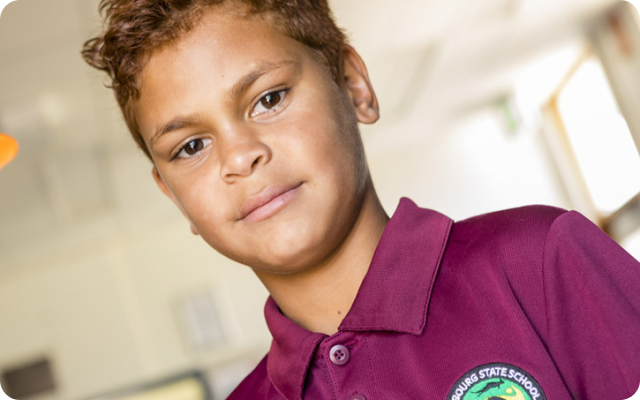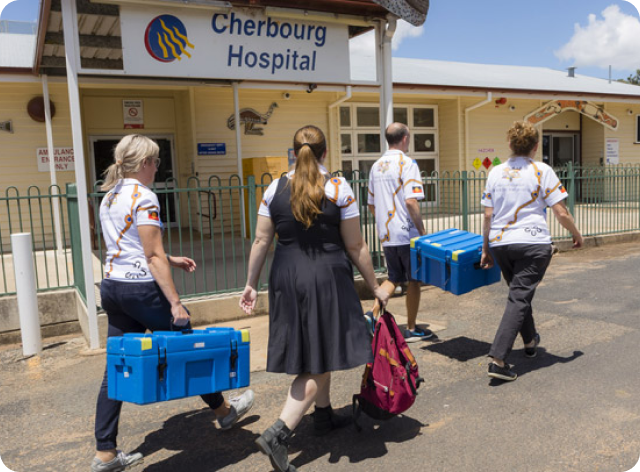Jamarl had poor hearing and would rarely speak when he first attended the Deadly Ears clinic in Cherbourg in February 2018. The then eight-year-old had been living with a perforated eardrum (holes in his eardrum) for at least three years, which meant every voice and sound he heard was muffled. This hearing loss made it hard for him to participate in lessons like his classmates at school, and his learning was suffering. Even engaging with his family and community proved challenging.
Jamarl’s story is not unique. Aboriginal and Torres Strait Islander children have some of the highest reported rates of middle ear disease and associated conductive hearing loss in the world.

“Approximately 70 per cent of the children referred to us present with some sort of middle ear disease or hearing loss,” says Matthew Brown, director of the Deadly Ears program, which delivers specialist ear and hearing health services for Indigenous children in 24 Queensland communities.
Last year the multidisciplinary team performed more than 1200 ENT health assessments, 1150 audiology assessments and 106 surgeries in outreach clinics.
"We take the expertise and care to them, and work with children and families in their communities to make sure they can hear early and hear well and fulfil their potential" Matthew says.
With Jamarl, the Deadly Ears outreach team diagnosed the problem and provided him with the corrective surgery he needed in the same week, and within his home community. The surgery, a myringoplasty, involves having a graft to repair the hole in the eardrum. Jamarl had the procedure on his left ear in February 2018, and then required another on his right ear in August 2019.
The procedure is relatively quick, performed in just under an hour by ear, nose and throat (ENT) surgeons but the result has been life-changing for Jamarl.
At his last follow-up appointment with the Deadly Ears team in February 2020, Jamarl’s two ear drums were intact and his hearing was found to be within normal limits.
“He’s a different boy to the one who walked into the clinic in 2018,” says Deadly Ears nurse Kirsten Bagley, who has helped Jamarl and his family along his journey.
"This is the beginning of great things for Jamarl"

Matthew Brown: The Deadly Ears Program provides an essential service because hearing is critical to children's development. One of the statistics is that in the health literature, Aboriginal and Torres Strait Islander children, unfortunately have the highest rates of early disease and associated conductive hearing loss in the world.
They don't get the stimulus that they otherwise would get from the world around. They can't hear their mum and dad talking to them. They can't hear their local stories. They can't develop upon a trajectory that supports them to be, for example, school ready by the time their school years come around. That then might play out in their ability to enjoy school. If you don't have a good experience in education, then you might not present yourself with the opportunities that otherwise should present. You might not be in a position where you can get a good job. So that cascading negative trajectory for a child who might otherwise go on without any intervention for their ears and hearing is not a good one. And that's part of the reason why we exist to make that positive intervention early, to set these kids off and fulfill their potential.
The Deadly Ears program goes into these local communities because in the very first instance, we're invited by the local communities to come and see their children. These communities recognized that there was an unacceptable burden of early disease and conductive hearing loss in their communities and living remotely. They have very little access to a specialist tertiary service, and especially a service that can do surgery in a local community. So we have good attendance by and large, we're probably one of the best attended outreach services that goes to a remote community, thereby underscoring the value that the families place in the work that we do, and we're very grateful for that.
When you work with, Aboriginal and Torres Strait Islander families, you have a great sense of purpose. You have a great sense that you can make a positive difference. They're a joy to engage with, to support, to learn from.
Kirsten Bagley: Jamarl, well, he's one of our star patients. Jamarl had myringoplasty with us last August. He had very poor hearing and he's just come back to see us today and I asked him if he can hear the TV better, and he said, yes, miss, it's perfect. It's just changed his life. He's a different boy who walked in in August last year. It's totally different. It just makes me so proud to be doing the job that I'm doing.
Matthew Brown: If I reflect on the last 12 years, I think the greatest achievement is not only the ability to support families from across Queensland, it's to have the support of an amazing team. They're very committed. , they are a fabulous group. I'm very fortunate to lead such a dedicated, highly skilled group of people without whom we would not be able to do what we do.
Kirsten Bagley: I love my job. I would do this job for free. There's nothing I don't love. I love from the moment we start packing the boxes to come on out on a trip. I love the interaction I have with hospital staff. It is an amazing opportunity. I've been coming to for nine years and I know a lot of the families that I actually see personally.
Matthew Brown: I think everyone in the program has the one vision and that is that we are no longer required to deliver our health service. We don't want to be in an environment where Aboriginal and Torres Strait Islander kids have the highest rates of early disease in the world. We want to change that.
The Deadly Ears program
The Deadly Ears program is part of the Deadly Kids Deadly Futures initiative, which aims to improve the health, early childhood development and education outcomes of Aboriginal and Torres Strait Islander children in Queensland. The initiative uses artwork by Margie Lankin featuring a turtle across its resources which represents the ear. Like turtles who swim silently under the surface of the rivers and oceans, childhood hearing loss and middle ear disease are silent – you don’t know it’s there unless you look.